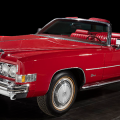Everybody was Kung Fu fighting
Hong Kong churned out hundreds of kung fu movies during the genre’s heyday. But beyond the campy dialogue and heroes who are triumphant against ridiculous odds, is an artistry that dates back thousands of years.
Little known fact: Before Bruce Lee became famous as a master of mixed martial arts, he danced his way to win the 1958 Cha-Cha championship of Hong Kong. The rhythm, fluid body movement, theatrical expression and exhaustive choreography of elaborate dance routines also are a requisite for the kung fu fight scenes Lee made famous, says Tom Vick, curator of film at the Freer and Sackler Galleries, the National Museum of Asian Art.

Bruce Lee during his Cha Cha Championship days.
Dramatized kung fu fighting is a film tradition with its roots in Hong Kong action movies featuring stars such as Lee and Jackie Chan with distinct influences from a variety of movie directors. “Different directors applied their individual styles to their fight scenes, some are more comedic, some more violent, some quicker, some slower, some more stylish and tension-building,” Vick observes.
To mark the 25th Anniversary of the Freer/Sackler’s annual Made in Hong Kong Film Festival last August, Vick invited Film Comment Magazine critic R. Emmet Sweeny to come up with a list of 25 great Hong Kong Action scenes from the last 25 years. Vick then posted Sweeny’s selections on the National Museum of Asian Art’s blog under the title “The Art of Action: 25 Years of Hong Kong Fight Scenes.” He then hosted Sweeny in an online program to show a few of the clips and discuss them. “It was a lot of fun and the audience really got into it,” Vick says.
The Torch spent some time with Vick to learn more about the beloved, slightly campy genre of kung fu movies.
Why did martial arts films come to prominence in Hong Kong?
The whole tradition of Hong Kong martial arts movies comes from China and Taiwan, partly emerging from Peking Opera traditions and a long history of Chinese literature about martial arts heroes. There are many novels going back one thousand years and more that are stories of heroes who do martial arts, so these have pretty much been translated to film. The physical nature of it comes out of traditional acrobatics and dance.
In the case of Hong Kong movies, there is a long tradition of marital arts battles, or kung fu fights. Elaborate shootouts between gangster gangs is also a part of this. If you check out R. Emmet Sweeney’s selection on the Freer/Sackler blog, you get a sense of the kind of variety of action scenes that exist. It has been a specialty of Hong Kong directors for many years now.
Two distinct examples are the 2016 movie “Three,” directed by Johnnie To. It is a highly choreographed shootout in a hospital that appears to be in slow motion. The interesting thing is that To didn’t shoot it in slow motion but had a dance choreographer come in and train all the actors and actresses to move very slowly. They were doing kind of tai chi moves and To had this very complicated choreography going on, with cameras moving in between the actors.
It was all filmed in real time with extremely carefully designed scenes, yet it looks like it was filmed in slow motion. It is just amazing.
On the other end of the spectrum is the very fast and physical step ladder scene from the 1996 film “Police Story 4: First Strike,” directed by Stanley Tong and starring Jackie Chan. Chan and other martial arts stars of his generation came up as kids working in the Peking Opera, which has this very acrobatic performance style. So, Chan became very physically agile, performing all these leaps and stunts from a very young age and he just applied those talents to film.
During the 1990s, Chan and his film crew kept a warehouse filled with objects and props that they practiced with to see what would work. In the “Police Story 4” scene they used a simple Stanley aluminum step ladder as a prop. While watching this scene, you can appreciate how much time they must have spent working out all the possibilities of what could be done with an aluminum step ladder, exploring it’s comedic and action potential at the center of an extended kung fu battle.
It is a fast and incredibly physical performance.
The directors go to great lengths to film these action scenes…
One thing I learned that I found fascinating, and it might be one reason Hong Kong action movies really stand out, is that it was once tradition that when a new movie premiered, during its first screening the director would sit in the front row, in front of the packed audience and watch the movie with them.
The audience knew he was there, and people would let him know if they liked what they were seeing and if they didn’t. This encouraged directors to make movies that were as audience-pleasing as possible, and as spectacular and unique as possible. If there is one reason there is this kind of great history of fun, exciting Hong Kong action movies, it is that directors had to answer for their work immediately to the public. American directors never had to do that. You can imagine the pressure.
Are kung fu action movies and American dance movies similar?
Kung fu action movies and dance movies such as “Singing in the Rain,” are similar in that much of the content of these films consists of characters acting out very realistic, normal events. Then they go into fantastic dance or action scenes where fantasy looms large. People float above lakes and fly through the air, and that kind of thing. What occurs depends exactly upon a director’s intention. The plot of these films can be realistic, but once an action or dance scene starts anything can happen.
In some cases, you can see where action stars like Jackie Chan may have been influenced by dancers such as Fred Astaire or Gene Kelly. I think Chan once said that he was influenced by violent movie comedians, such as Buster Keaton. Still, the whole tradition of martial arts movies first developed on its own in China and Taiwan and partly came out of Peking Opera traditions. There is also a long history of Chinese literature about these martial arts heroes.
Do American action stars like Steven Seagal and Chuck Norris have Hong Kong traditions to thank for their popularity?
American action stars got their moves from Hong Kong films. You could say it is a toss-up as to whether it was stealing or just being influenced. Originally, early action movies in America were gunfights and occasionally a fist fight. The kind of Steven Segal, Chuck Norris action you see today definitely innovated in Hong Kong.
Why are there not more female action stars?
In the United States martial arts action films are a very male genera, but, in Hong Kong and China there have always been female action heroes. There are famous actresses who specialize in action who have been around a long time. There are not as many females as guys but more than in the United States. That is starting to change, however. More female stars are emerging in the U.S.
Do you have a favorite action star?
I hate to play favorites, but I love Jackie Chan’s movies and fight scenes. He’s just amazing to watch, the way he injects humor and will put in these little pauses. He is always thinking about how to make a fight scene funny and create a rhythm. With Bruce Lee fight scenes were always extremely serious. When Jackie Chan came along, he wanted to put a different spin on it, be unique, so he decided he would include comedy in his stuff and that is what distinguishes him.
And then on the other hand the director of that slow-motion fight scene in, Johnny To, he does these very elegantly staged scenes and very kind of creatively presents it, you know it’s almost like he sets problems for himself to try to solve. With him it is more about the use of the camera and building tension and this very rich visual kind of style and presentation. These are two extremes but two that I like a lot in their own ways.
During this pandemic are you getting a good online turn-out for the films you present?
With our video-on-demand platform of streaming films, coupled with live discussions in between, a lot of people are tuning in. Why? I think because it is free and people don’t have to make the effort to get in their car, drive to the movie theater and take a chance on something they may not know or like.
People are more willing to take a chance on streaming stuff and that’s been great. I mean we are getting out there and getting good attendance numbers. I do miss the live experience. Movies should be seen in a theater with a crowd but, of course doing it this way with live streaming is the second-best thing.
If anything, live streaming gives me the opportunity to be a little more adventurous in the programming, maybe show films that people might not be familiar with because they are more willing to check them out in this environment. There are advantages to it, and it is fun to put these things together. We’re going to be doing a science fiction series later this year which will be a lot of fun. That part keeps me going.
Can you give an example?
In September I hosted online a panel discussion inspired by “Be Water,” a documentary on Bruce Lee that is currently streaming on ESPN. The documentary focuses on the fact that protestors in Hong Kong have adopted “Be Water” as a tactic in their battles with the Chinese police. “Be Water” is an idea that Bruce Lee used that focused on the strength and adaptability of water. Water is both strong and perpetually capable of motion. So, the protestors consciously made it their slogan, describing how they confront the police.
I thought it was intriguing they had adapted Lee’s idea because, during his life Bruce Lee was very committed to racial justice and social causes. His films often depicted him as a minority fighting against white supremist foes. This was picked up on by hip hop artists and graffiti artists in New York in the 1970s. Lee was sort of an icon to them, so one of the people that I included on the panel was Fab Five Freddy, a TV rap and graffiti artist and a painter. He did a series of paintings inspired by Bruce Lee referencing his relation to Bruce Lee when he was young.
It is fascinating how Bruce Lee goes beyond just being a guy who fights in kung fu movies to someone who has this huge influence beyond film. Bruce Lee’s daughter was on the panel, as was “Be Water” director Bao Nguyen, and Jeff Chang, who is currently writing a biography of Bruce Lee.
One advantage of working in this new virtual world is that I can get people from all over to participate in these events rather easily, because we don’t have to worry about travel. We were all together on Zoom. There’s no way I could easily get all these people together in one physical place. I was able to get people to participate in these events rather easily on Zoom. That’s a big deal.

Tom Vick is Curator of Film for the Freer and Sackler Galleries, the National Museum of Asian Art
Tom Vick is curator of film at the Freer and Sackler and the author of “Time and Place are Nonsense: The Films of Seijun Suzuki and Asian Cinema: A Field Guide.”
Editor’s note: And just for fun, here is our own Kung Fu Panda, who has no moves at all at this point.
Posted: 19 October 2020
- Categories:






